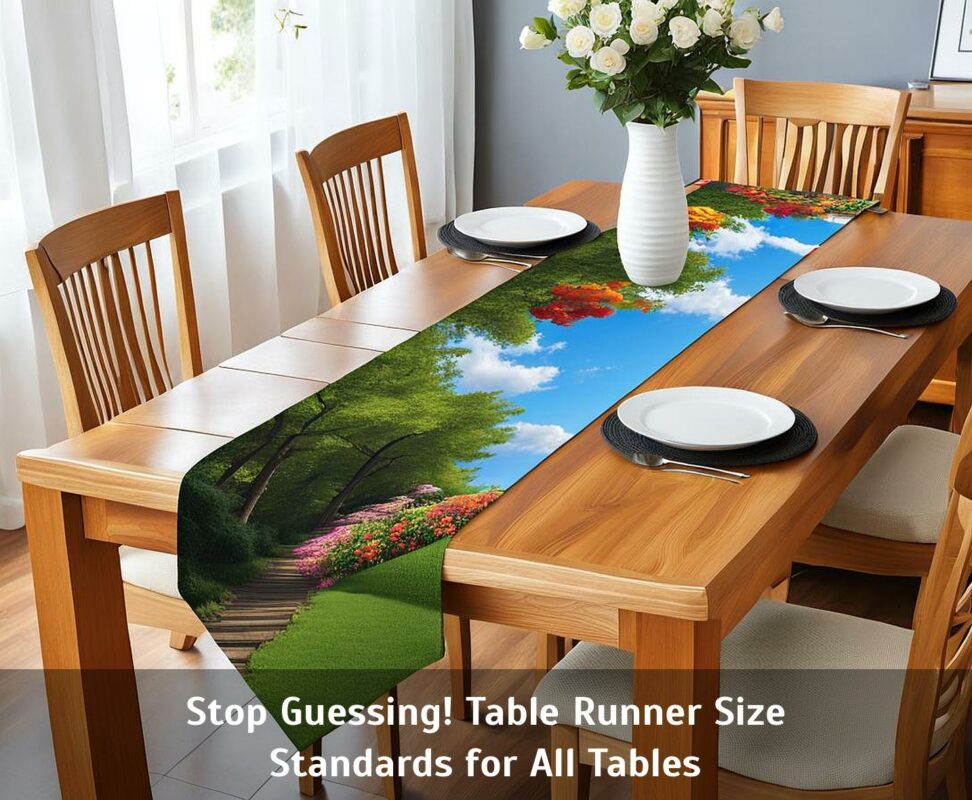Stop Guessing! Table Runner Size Standards for All Tables
Choosing the perfect table runner to ornament and protect your dining table should be simple. But countless hosts wrestle with questions around ideal sizing. Will this runner span the whole surface? Do these measurements allow that refined overhang? Why does this linen swallow my table whole?
Fret no more! Follow our standards to select table runners that balance beauty and function flawlessly.
Key Factors in Choosing Table Runner Size
Table Width
An adequately wide table runner elegantly frames your tablescape without squeezing place settings. For best proportions, your runner's width should equal about one-third of your table's width. So for a popular 60-inch wide rectangular dining table, choose a runner around 20 inches wide.

Check precise width pairings below to find your table's ideal runner width:
- 30-inch table = 10-inch runner
- 36-inch table = 12-inch runner
- 42-inch table = 14-inch runner
- 48-inch table = 16-inch runner
- 60-inch table = 20-inch runner
- 72-inch table = 24-inch runner
- 84-inch table = 28-inch runner
Table Length
When it comes to runner length, resist skimping! A runway of at least 12 inches extending equally beyond both table ends polishes off your layout magnificently. This generous overhang flatters rounded edges too by cloaking their curves.
Meanwhile, casual decor permits smaller runners mainly highlighting the table's center. But never settle for scant overhang that looks obviously too short.
Table Shape
For elongated rectangular tables, apply the width and length standards above without adjustment. Simply center your sized runner down the table's midline.
Rounded tables oblige slightly tweaked numbers. Add a couple extra inches all around to gracefully drape the runner over curved edges. And determine width at the table's widest midpoint instead of the literal diameter.
Decor Style
Formal tablescaping warrants the most generous runner dimensions to uphold elegance. Strive for both ample width and maximum overlap from an opulent overhang.
Meanwhile, casual decor allows you to downsize. Narrower widths still balance proportions if they cover the flat middle surface. And you need just enough length to highlight the centerpiece without strict overhang rules.
Measurements Cheat Sheet by Table Size
Keep this reference chart on hand whenever table runner shopping to confirm suitable sizes!
| Table Width | Runner Width | Table Length | Runner Length |
| 30 inches | 10 inches | 48 inches | 60 inches |
| 36 inches | 12 inches | 60 inches | 72 inches |
| 42 inches | 14 inches | 72 inches | 84 inches |
| 48 inches | 16 inches | 84 inches | 96 inches |
| 60 inches | 20 inches | 96 inches | 108 inches |
Getting It Right: Calculating Your Size Needs
Gather Table Dimensions
Start by recording accurate width, length, and shape details of the table you want to dress up. For reliable numbers, physically measure your furniture using a tape measure or ruler. Don't guess or rely on recalled dimensions!
Note if your table features rounded corners, an oval silhouette, or unique attributes like leaves to account for while sizing.
Figure Desired Overhang
Next decide how much overhang suits the formality of your event. Fancy multi-course dinners demand that lavish 12-inch drape for visual intrigue. But casual family meals would shine with a runner sitting nearly flush to the edges.
Size Selection Guidelines
Now unite your numbers with our standards to identify spot-on runner proportions. Our long-held formula says your runner should measure about one-third your table's width. And extend an equal overhang distance beyond both ends based on your length notes.
So for a 48-inch wide by 78-inch long table dressed for a relaxed dinner party, you want a 16-inch wide runner that's 90 inches (78 + 2 x 6 inches) long. Voila - no more guesswork!
Shopping with Confidence for Perfect Fits
Our guidelines erase all doubt surrounding accurately sized selections. So browse for runners without that nagging what if? in your mind!
Focus first on getting those make-or-break width and length numbers right. Then feel free to assess other variables like materials, decorative trims, color schemes, and price points to pick your personal favorite option.
Style Considerations Beyond Size
Once you've secured an optimally sized table runner, explore creative styling. Layer two different runners down the table's length for contrasting textures and patterns. Or adorn each place setting with individual runners for a personalized touch.
Just take care not to disrupt your runner's clean lines and crisp silhouette. Anything shorter or longer than yourIntent for runners mainly highlighting the table's center. But never settle for scant overhang that looks obviously too short.
will look sloppy and amateur.Common Sizing Mistakes to Avoid
With our simple guidelines, you can sidestep these cringe-worthy pitfalls:
- Undersized : Skimping on width or length leaves awkward gaps of bare table.
- Oversized : An overwide or extremely long runner overpowers the whole table.
- Uneven : Runners askew from improper center placement undermine symmetry.
Take the stress out of festooning your dining table in style. Follow our strategic size standards for table runners that balance beautifully without adjustment.
Simply assess your table's shape and dimensions, gauge the right overhang, and calculate paired runner widths plus lengths. Then revel in decorating with perfect proportional poise and polish!